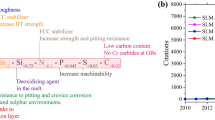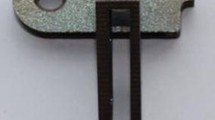Abstract
The boring and trepanning association deep hole drilling of materials with a high tendency to adhesion, such as high alloyed-steels, is characterized by a poor surface quality of the bore hole. Material particles adhere to the guide pads that are positioned on the circumference of the drill head and that are normally responsible for the outstanding workpiece quality. In order to prevent this mechanism the guide pads were coated with an innovative amorphous and tetrahedral bonded (ta-C)-coating. This coating has a reduced friction coefficient of 0.1 against steel and a hardness coefficient of about 7,000 HV. To use the benefits of this ta-C-coating the pre- and the after-treatment of the uncoated carbide substrate and ta-C-coated guide pads are essential. For these process steps a microfinishing process was carried out as an alternative to the conventional treatment by polishing and brushing. The microfinishing of the uncoated guide pads effects a smooth surface that is necessary for an optimum bonding strength of the ta-C-coating at the carbide substrate. Furthermore the chamfer edge in the lead-in-area is rounded which reduces the mechanical load at this specific area during the process. The finishing process of the coated guide pads reduces the coating defects and improves the friction coefficient. Thus, the wear behavior of the guide pads is improved because of the better friction conditions during the drilling process of high alloyed steels.









Similar content being viewed by others
References
NN (1989) VDI-Richtlinie 3209 Blatt 1, Tiefbohren, richtlinie für das tiefbohren mit äußerer zuführung des kühlschmierstoffes (BTA- und ähnliche Verfahren). Verein Deutscher Ingenieure, Düsseldorf
Heisel U, Stortchak M, Eisseler R (2002) Optimization of deep hole drilling processes with smallest drilling diameters. Prod Eng Res Devel 1:157–163
Biermann D, Kessler N (2011) Modified DLC-coated guide pads for BTA deep hole drilling tools. Eng Mater 438:195–202
Khellouki A, Rech J, Zahouani H (2007) The effect of abrasive grain’s wear and contact conditions on surface texture in belt finishing. Wear—An Int J Sci Technol Frict, Lu-br Wear 263:81–87
Goeke S, Würz K, Biermann D (2012) Improving the shape accuracy by simulating the short-stroke honing process. J Mech Eng Autom 2(8):507–513
Varghese B, Malkin S (1998) Experimental investigation of methods to enhance stock removal for superfinishing. Ann CIRP 47(1):231–234
Westkämper E, Michel S (1995) Film finishing—technological investigations and process monitoring. Prod Eng II 2:11–14
Scheibe HJ, Siemroth P (1990) IEEE Trans Plasma Sci 18(6):911–916
Witke T et al (1999) Deposition of hard amorphous carbon coatings by laser and arc methods. Surf Coat Technol 116:609–613
Scheibe HJ et al (1997) Mechanical properties of laser-assisted deposited amorphous carbon films. Conference paper presented at the international specialist meeting on amorphous carbon (SMAC), vol 1, Cambridge, pp 252–261
Weinert K, Bruchhaus T (1999) Tribological investigations into the operational behavior of self-piloting drilling tools. Wear 225–229(2):925–935
Bruzzone AAG, Costa HL, Lonardo PM, Lucca DA (2008) Advances in engineered surfaces for functional performance. Ann CIRP 57(2):750–769
Acknowledgments
The investigations described in this paper were carried out with the support of the “Deutsche Forschungsgemeinschaft” (DFG) within a special research project „Tribologische Optimierung der Gestalt und Beschichtung von Führungsleisten für das BTA-Tiefbohren von hochlegierten Stählen“(GZ: BI 498/29-1).
Author information
Authors and Affiliations
Corresponding author
Rights and permissions
About this article
Cite this article
Biermann, D., Abrahams, H. & Goeke, S. Optimization of guide pads for the BTA deep hole drilling of high alloyed steels by microfinishing. Prod. Eng. Res. Devel. 8, 33–40 (2014). https://doi.org/10.1007/s11740-013-0505-z
Received:
Accepted:
Published:
Issue Date:
DOI: https://doi.org/10.1007/s11740-013-0505-z




